ISSN ONLINE(2319-8753)PRINT(2347-6710)
ISSN ONLINE(2319-8753)PRINT(2347-6710)
Hasan Ş. Haştemoğlu1 and İlker Erkan2
|
| Related article at Pubmed, Scholar Google |
Visit for more related articles at International Journal of Innovative Research in Science, Engineering and Technology
The main idea of the study is to determine the standards which will be used to evaluate Airport Terminal Buildings, and to generate a standard to collect departing passenger satisfaction, to identify root causes of problematic issues raising dissatisfaction level of passengers, and to formulate necessary solutions for decreasing or limiting the dissatisfaction level(s). In this study, it is aimed to construct an evaluation standard which is based on passenger perception for either international or national passenger terminals which have inadequate data, and to obtain initial data from a generalizable sample group. The analyses determine the strengths and weaknesses of airport terminal building depending on the departing passenger perception. This study is believed to be beneficial for generating design decisions which will be effective on future terminal building designs. In that sense, it is addressed to the issues which are needed to be given priority within the scope of passenger satisfaction. The case study area is determined as the Süleyman Demirel Airport in Isparta (ISDA). This study has revealed the fact that it is important to consider the "satisfaction" concept which has direct influences on design parameters through the common domain of tourism and transportation sciences.
Keywords |
| Passenger satisfaction, Terminal Building Architecture, Evaluation Standard, ISDA Terminal |
INTRODUCTION AND LITERATURE REVIEW |
| Passenger satisfaction is one of the most critical issues which are needed to be analysed carefully for both study areas. The remarkable steps of the Turkey within the transportation sector in order to take an important place among the world of tourism sector are seen obviously. There are not any adequate and remarkable studies which measure passenger perception and related satisfaction levels, as well as analyse them in Turkey. It is believed that there is a need of such a standard and active application, and this standard will be helpful in order to achieve a high quality performance for passenger needs through the airport terminals. This study performs a similar evaluation method which sustains a continuing quality and performance development system based on user satisfaction and needs through the establishment of a measurement scale that evaluate passenger perception.The main aim of the study is to develop a standard evaluation model related to departing passenger perception in airport terminal buildings, and to propose strategies for eliminating passenger dissatisfaction which also take into account of airport terminal architecture. Case study area is determined as the Isparta Süleyman Demirel Airport (ISDA) which is not given any reference about through the literature in Turkey. This airport is chosen due to some specific reasons such as its constant growing passenger numbers, continuing development capacity, and positive effect for the Mediterranean region airports' capacities in terms of sharing the passenger load among those airports. The framework of this study is constructed on developing an index value to measure the passenger satisfaction through a model applied in the ISDA Terminal. The International Air Traffic Association (IATA) conducted a survey and published under the title of "Airport Monitor" which evaluates airport services' quality through 16,000 transatlantic passenger questionnaires [1]. Barros [2] examined the satisfaction level of passengers from departing and arriving ones to the transit passengers who have special needs when using the terminal services. The survey was conducted with a small group (n=23) of transit passengers, a 22-item query allowed to develop needed linear regression analysis and be finalized it. Lemer [3] tried to investigate the "adequate performance" term which could be used to evaluate airport terminals from procedural/systematic and theoretical view point. In addition, passenger think a labyrinth like terminal building has negative impacts on the passengers and may cause the flight to miss due to wayfinding problems; it is possible to lower the stress and dissatisfaction of passengers by using or locating exciting symbolic forms. Hastemoglu and Erkan [4] analyse that pedestrian flow analyse and wayfinding with social force model in small scale airport in Turkey. Correia [5] presented a level of service related to user perception for airport passenger terminals. Seneviratne and Martel [6] were conducted in Canada airports, and depending on the specifications which had strong influences on user perception. Erkan [7] also analyse level of service for passengers in small scale airport in Turkey. This research shows that level of service factor affecting to passenger orientation and movement ability. Yeh and Kuo [8] proposed a measuring experience for passenger service quality which was titled as "an overall service performance index for each airport obtained by incorporating the decision makers confidence level and preference on fuzzy assessments of the respondents". Manataki and Zografos [9] proposed an evaluation model which was implemented in Athens Airport passenger terminal and which focused on the healthy functionality of a terminal building in different conditions. |
RESEARCH METHODOLOGY |
| The terminal (ISDA) in which the study was conducted has a potential of serving to constantly growing passenger population. ISDA is an airport which has a passenger capacity of 1.500.000 annually. In 2011, the domestic passenger numbers have reached to 70.000 which are accepted as the highest domestic number. The Fig. 1 displays the total passenger numbers of the airport in the past years. |
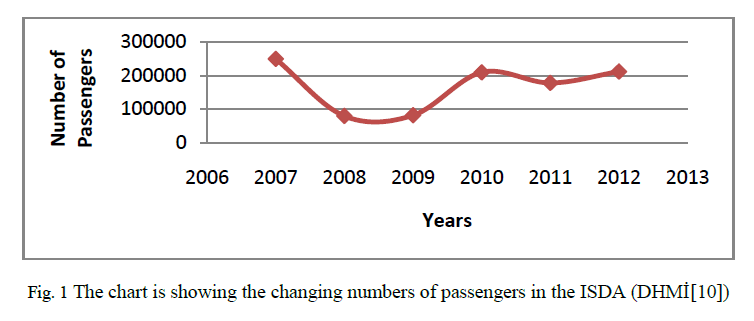 |
DEVELOPMENT OF THE ISDA EVALUATION SCALE |
| The main objectives of the study can be given as follows; primarily, it is aimed to develop a criterion which can be used in evaluating the airport terminal buildings from the point of passengers; secondly, it is aimed to enhance this criterion in time in order to develop an adaptive model which can be applied for all airport terminals, lastly, it is aimed to investigate for the dissatisfying conditions which are complained most by the passengers, and to develop strategies in order to find solutions for those complaints. The evaluation model applied in the study is presented in the Fig. 2. |
 |
| The population of the research is composed of both domestic and international passengers who use the ISDA. According to the DHMI data, the total passenger number including both the arrivals and departing recorded at the end of December which belongs to the year 2011 is 178.412. According to the change in monthly passenger numbers given in the Figure 3, it is possible to address the most peak use period of the ISDA as the months between the August to December. |
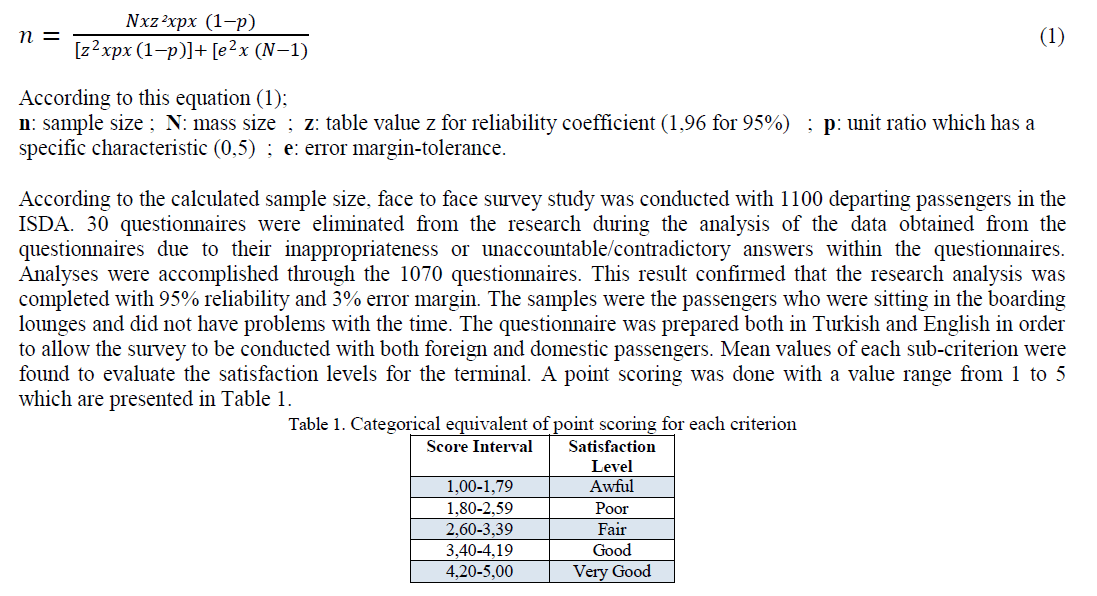 |
| A categorization due to mean value of the point scoring is produced and presented in the Table 1 as well. In that sense, perceptual/sensory effect and functional usage characteristics of entrance hall and check-in areas were examined. Linear regression analyses were used to determine the direction and size of the factors which were effective on the satisfaction level from boarding lounges and utilization of the all other spaces in the terminal building. Other data sources rather than the questionnaires such as photography/camera records were also used during the analysis of the survey results. The Table 2 represents the characteristics of the survey participants which is developed under four main titles. |
 |
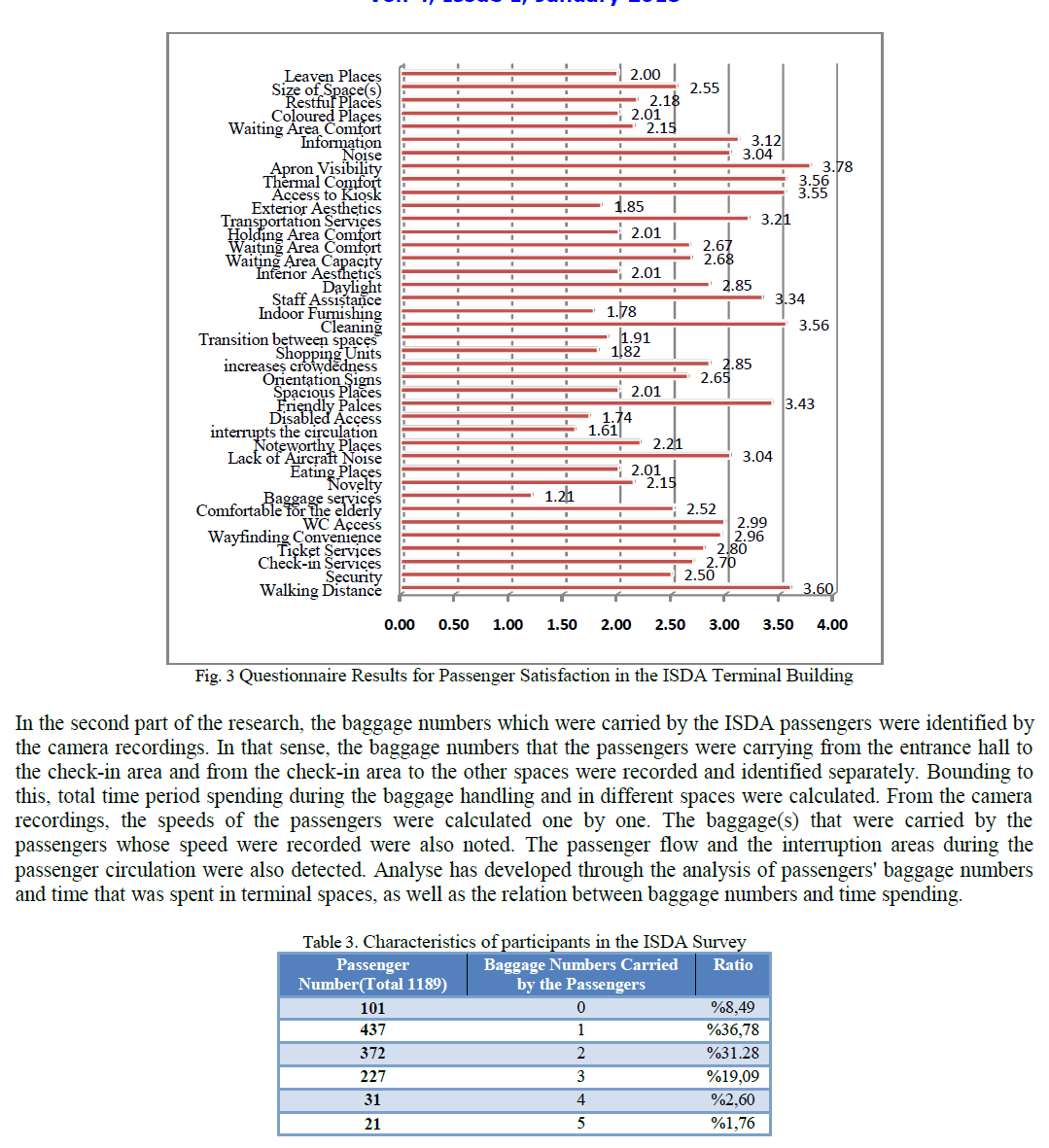 |
| The baggage numbers carried by the participants, their speed, and the time spent within the spaces were determined for the accepted surveys. Besides, the same data (baggage numbers/speed/time spent) for the non participants who did not participate to the questionaries were also identified. As the results presented in the Table 4 have revealed that 101 of the 1189 passengers had no baggage to be claimed, 21 passengers had too many baggage which was very difficult for them to carry without baggage cars. |
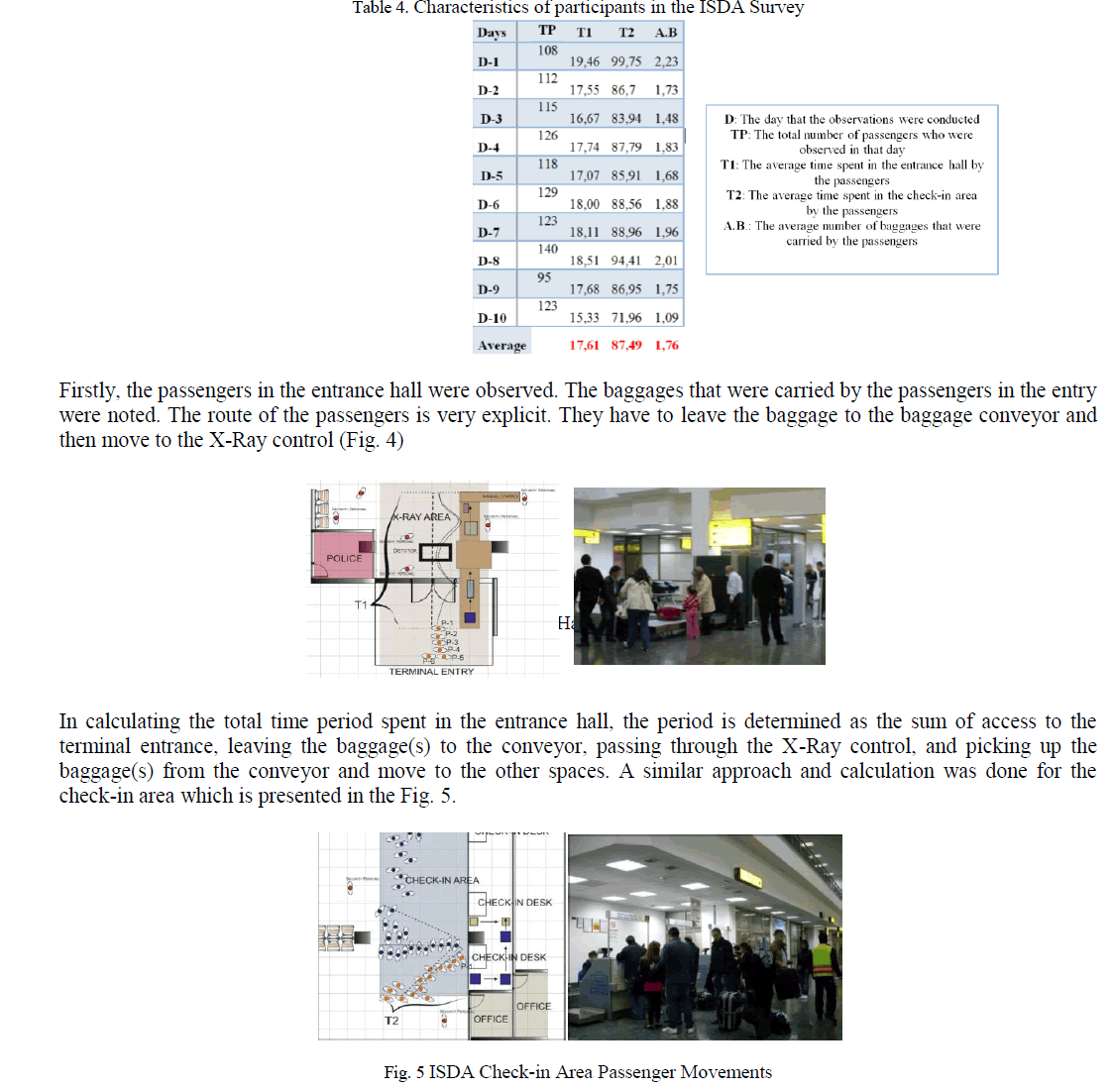 |
| Time period has calculated and accepted as the sum of the following movements; coming into line with the baggage(s), receiving the boarding pass, and delivering the baggage(s). The cabin baggages were eliminated from this calculation. The reason for this elimination is that the cabin baggages (such as laptop, back-pack) are not effective widely on the comfort level of the passengers. The time spent in both areas (entrance and check-in) are effective on the satisfaction level of the passengers. This influence can be increased in a positive way through decreasing the time period or increasing the comfort. The examination was composed of ten different days in which the survey and the observations were conducted. According to the observations and analysis, the waiting time for the entrance hall varies from 15 to 22 seconds, whereas this interval varies from 59 to 100 seconds for the check-in area. The models produced for the baggages and waiting time of the passengers for the entrance hall and check-in area are given as follows: |
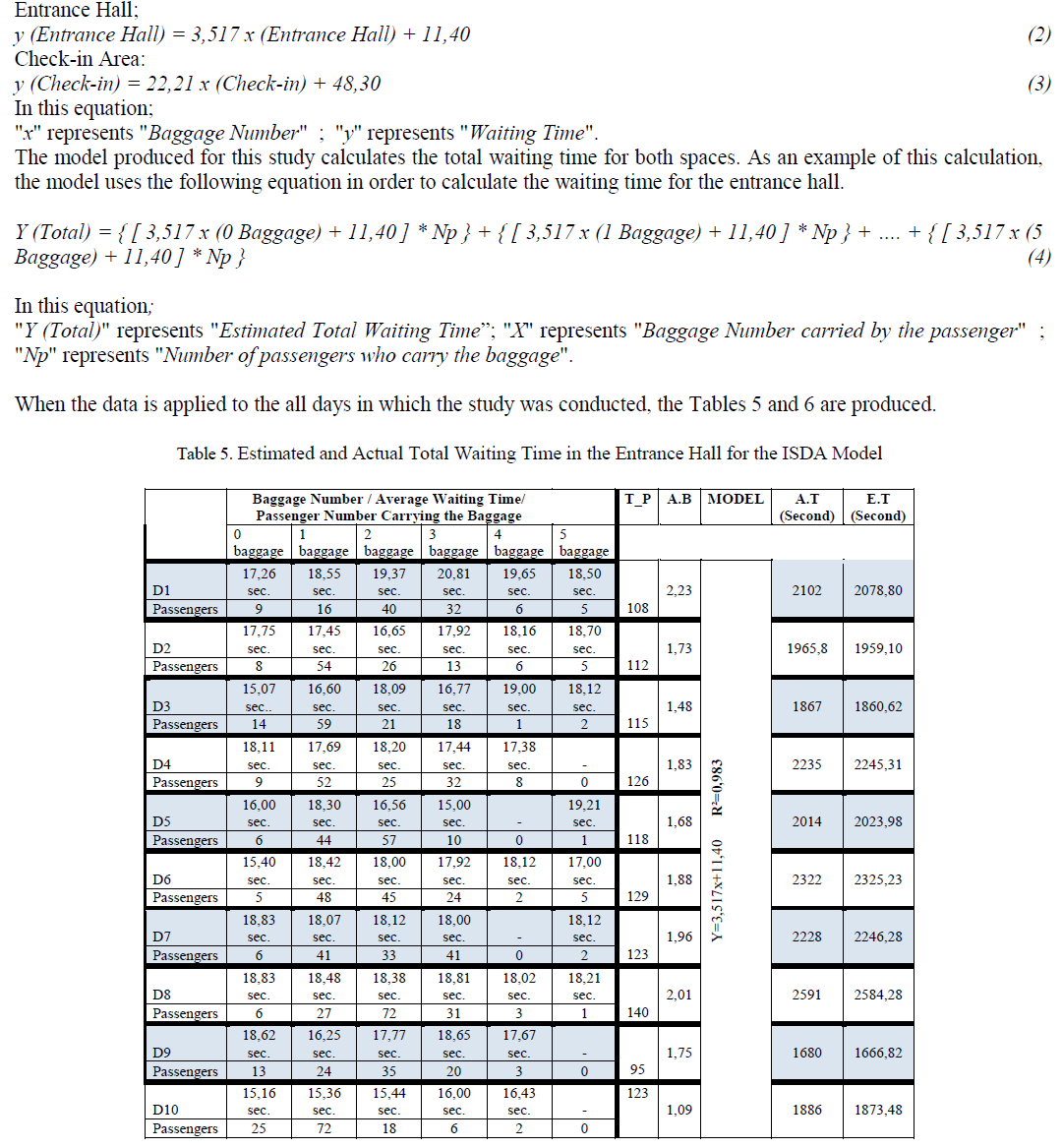 |
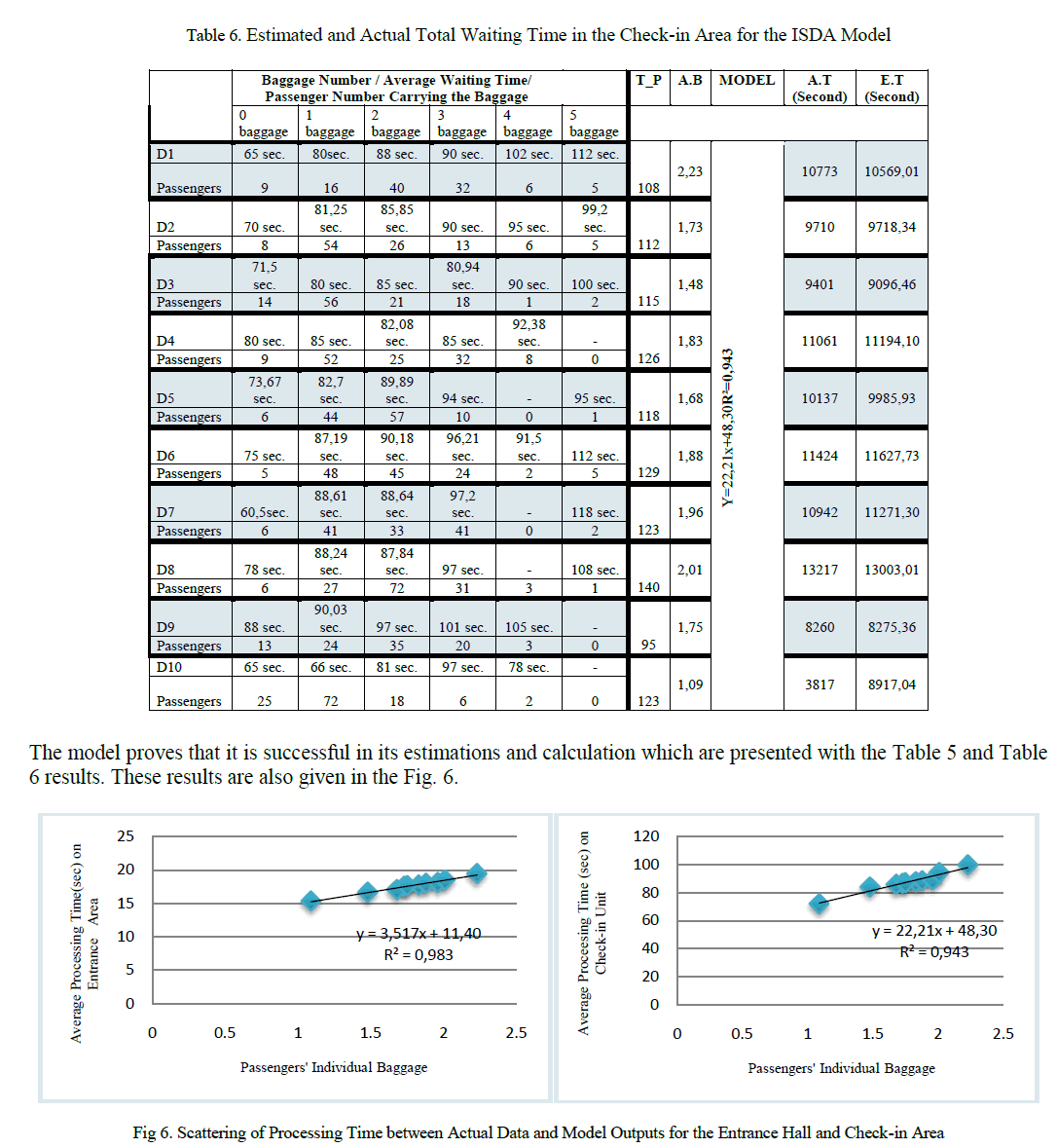 |
| When the tables are examined thoroughly, the total time which is calculated through the estimation of the model is very close to the one which is found through the site observations and analysis. From those data, according to the camera records, total waiting time that the passengers’ spent in the entrance hall was recorded as 2102 seconds. According to the calculation of the formula (2) of the Model, the total waiting time for those people is 2078, 80 seconds. As a result, the ration of estimated time to actual (observed) time in terms of total waiting time of 108 passengers in the entrance hall equals to 1,01. |
CONCLUSION AND DISCUSSION |
| This study has taken into account of all characteristics mentioned above, and asserts that elaborated designs result in high level of user satisfaction in terminal buildings. The researches which were done about the crowdedness of the terminals, such as the works of Lemer [3] and Janic [1] point out the importance of crowdedness as a determiner of satisfaction level although these researches were conducted in relatively less crowded time periods. There are many examples among the literature survey related to the evaluation of waiting lounges ([4];[7];[10];[11];[12];[13]). The comfort level and conditions of waiting seats is the most common evaluation scale for these spaces encountered in these studies very often. In that sense, it can be beneficial to use the models such as Lens Model [14] which resolve the interrelation of aesthetic perceptions and physical characteristics. An interesting result has obtained in this study from the research on services/satisfaction from services both of which are included in many studies very often as determined in literature survey. If satisfactions from services which stands out in different contexts are tested with spatial standards, they fade into background. This result reveals that spatial standards are as important as, even sometimes more important than the service quality during the passenger evaluations. According to the literature survey, many studies reveal the importance of food court and shopping service satisfactions very often ([10];[11];[12];[13]). According to finding, passengers prefer to spend time in a seating arrangement which also provides eating and drinking, as well as snacking services rather than waiting in a standard seating area arranged in lines. This finding can be used as an alternative in design of departure waiting lounge services including furniture arrangement and location. at entrance hall and check-in areas, passengers who spend more time have the ones who have more baggages. Due to the impossibility to demand from the passengers for reducing their baggage numbers, it is necessary to arrange indoor spaces in order to find solutions for the loss of time. The foremost solution alternative is to make it easy to access to the baggage cars. However, this approach is not convenient for the entrance hall area because baggage car arrangement in this area can be a barrier for the circulation system. The baggage problem and long waiting periods particularly in the entrance hall have the negative impacts on the passenger satisfaction, and are directly related with the terminal building architecture. The major objective of a solution for this problem has to take into account of easy access to the baggage cars and the arrangement of these cars without being a barrier for the circulation. Instead, it is needed to develop measurement standards necessary and recognized for the design of all types of terminal buildings in order to secure passenger comfort and satisfaction successfully. ISDA Terminal, it can be a positive solution to design and build a pre-entrance space in which passengers can access conveniently in order to find a baggage car. |
References |
|